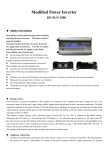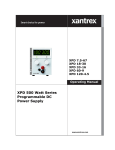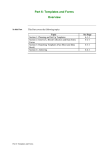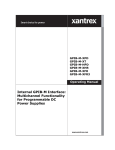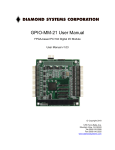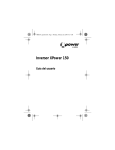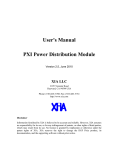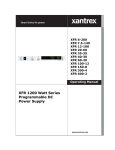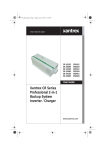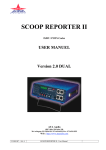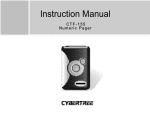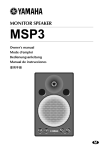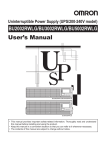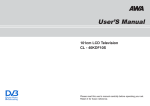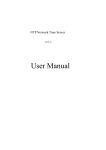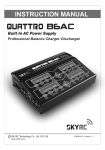Download XANTREX XT 15
Transcript
XT XT XT XT XT XT XT 7-6 15-4 20-3 30-2 60-1 120-0.5 250-0.25 Operating Manual XT 60 Watt Series Programmable DC Power Supply Operating Manual for XT Series Programmable DC Power Supply Limited Warranty What does this warranty cover and how long does it last? This Limited Warranty is provided by Xantrex Technology, Inc. (“Xantrex”) and covers defects in workmanship and materials in your XT 60 Watt Series DC Power Supply. This warranty lasts for a Warranty Period of 5 years from the date of purchase at point of sale to you, the original end user customer. What will Xantrex do? Xantrex will, at its option, repair or replace the defective product free of charge, provided that you notify Xantrex of the product defect within the Warranty Period, and provided that Xantrex through inspection establishes the existence of such a defect and that it is covered by this Limited Warranty. Xantrex will, at its option, use new and/or reconditioned parts in performing warranty repair and building replacement products. Xantrex reserves the right to use parts or products of original or improved design in the repair or replacement. If Xantrex repairs or replaces a product, its warranty continues for the remaining portion of the original Warranty Period or 90 days from the date of the return shipment to the customer, whichever is greater. All replaced products and all parts removed from repaired products become the property of Xantrex. Xantrex covers both parts and labor necessary to repair the product, and return shipment to the customer via a Xantrex-selected non-expedited surface freight within the contiguous United States and Canada. Alaska and Hawaii are excluded. Contact Xantrex Customer Service for details on freight policy for return shipments outside of the contiguous United States and Canada. How do you get service? If your product requires troubleshooting or warranty service, contact your merchant. If you are unable to contact your merchant, or the merchant is unable to provide service, contact Xantrex directly at: ii Phone: 604 422 8595 Toll Free North America: 1 800 667 8422 Fax: 604 421 3056 Email: [email protected] Operating Manual for XT Series Power Supply Direct returns may be performed according to the Xantrex Return Material Authorization Policy described in your product manual. For some products, Xantrex maintains a network of regional Authorized Service Centers. Call Xantrex or check our website to see if your product can be repaired at one of these facilities. In any warranty claim, dated proof of purchase must accompany the product and the product must not have been disassembled or modified without prior written authorization by Xantrex. Proof of purchase may be in any one of the following forms: • • • The dated purchase receipt from the original purchase of the product at point of sale to the end user, or The dated dealer invoice or purchase receipt showing original equipment manufacturer (OEM) status, or The dated invoice or purchase receipt showing the product exchanged under warranty What does this warranty not cover? This Limited Warranty does not cover normal wear and tear of the product or costs related to the removal, installation, or troubleshooting of the customer’s electrical systems. This warranty does not apply to and Xantrex will not be responsible for any defect in or damage to: a. the product if it has been misused, neglected, improperly installed, physically damaged or altered, either internally or externally, or damaged from improper use or use in an unsuitable environment; b. the product if it has been subjected to fire, water, generalized corrosion, biological infestations, and high input voltage from lightning strikes; c. the product if repairs have been done to it other than by Xantrex or its authorized service centers (hereafter “ASCs”); d. the product if it is used as a component part of a product expressly warranted by another manufacturer; e. the product if its original identification (trade-mark, serial number) markings have been defaced, altered, or removed. Release 2.2 iii Disclaimer Product THIS LIMITED WARRANTY IS THE SOLE AND EXCLUSIVE WARRANTY PROVIDED BY XANTREX IN CONNECTION WITH YOUR XANTREX PRODUCT AND IS, WHERE PERMITTED BY LAW, IN LIEU OF ALL OTHER WARRANTIES, CONDITIONS, GUARANTEES, REPRESENTATIONS, OBLIGATIONS AND LIABILITIES, EXPRESS OR IMPLIED, STATUTORY OR OTHERWISE IN CONNECTION WITH THE PRODUCT, HOWEVER ARISING (WHETHER BY CONTRACT, TORT, NEGLIGENCE, PRINCIPLES OF MANUFACTURER’S LIABILITY, OPERATION OF LAW, CONDUCT, STATEMENT OR OTHERWISE), INCLUDING WITHOUT RESTRICTION ANY IMPLIED WARRANTY OR CONDITION OF QUALITY, MERCHANTABILITY OR FITNESS FOR A PARTICULAR PURPOSE. ANY IMPLIED WARRANTY OF MERCHANTABILITY OR FITNESS FOR A PARTICULAR PURPOSE TO THE EXTENT REQUIRED UNDER APPLICABLE LAW TO APPLY TO THE PRODUCT SHALL BE LIMITED IN DURATION TO THE PERIOD STIPULATED UNDER THIS LIMITED WARRANTY. IN NO EVENT WILL XANTREX BE LIABLE FOR ANY SPECIAL, DIRECT, INDIRECT, INCIDENTAL OR CONSEQUENTIAL DAMAGES, LOSSES, COSTS OR EXPENSES HOWEVER ARISING WHETHER IN CONTRACT OR TORT INCLUDING WITHOUT RESTRICTION ANY ECONOMIC LOSSES OF ANY KIND, ANY LOSS OR DAMAGE TO PROPERTY, ANY PERSONAL INJURY, ANY DAMAGE OR INJURY ARISING FROM OR AS A RESULT OF MISUSE OR ABUSE, OR THE INCORRECT INSTALLATION, INTEGRATION OR OPERATION OF THE PRODUCT. Exclusions If this product is a consumer product, federal law does not allow an exclusion of implied warranties. To the extent you are entitled to implied warranties under federal law, to the extent permitted by applicable law they are limited to the duration of this Limited Warranty. Some states and provinces do not allow limitations or exclusions on implied warranties or on the duration of an implied warranty or on the limitation or exclusion of incidental or consequential damages, so the above limitation(s) or exclusion(s) may not apply to you. This Limited Warranty gives you specific legal rights. You may have other rights which may vary from state to state or province to province. iv Operating Manual for XT Series Power Supply Information WITHOUT LIMITING THE GENERALITY OF THE FOREGOING, UNLESS SPECIFICALLY AGREED TO BY IT IN WRITING, XANTREX a. MAKES NO WARRANTY AS TO THE ACCURACY, SUFFICIENCY OR SUITABILITY OF ANY TECHNICAL OR OTHER INFORMATION PROVIDED IN MANUALS OR OTHER DOCUMENTATION PROVIDED BY IT IN CONNECTION WITH THE PRODUCT; AND b. ASSUMES NO RESPONSIBILITY OR LIABILITY FOR LOSSES, DAMAGES, COSTS OR EXPENSES, WHETHER SPECIAL, DIRECT, INDIRECT, CONSEQUENTIAL OR INCIDENTAL, WHICH MIGHT ARISE OUT OF THE USE OF SUCH INFORMATION. THE USE OF ANY SUCH INFORMATION WILL BE ENTIRELY AT THE USER’S RISK. WARNING: Please refer to your product user manual for limitations on uses of the product. Limitations Specifically, please note that this power supply is not intended for use in connection on Use with life support systems and Xantrex makes no warranty or representation in connection with any use of the product for such purposes. Xantrex Technology, Inc. 8999 Nelson Way Burnaby, British Columbia Canada V5A 4B5 Information Please record the following information when you first open your Power Supply About Your package: Power Model Number ______________________________________________ Supply Serial Number ______________________________________________ Purchased From ______________________________________________ Purchase Date ______________________________________________ Release Release 2.2 (2003/04) Copyright © 2002 Xantrex Technology Inc. All rights reserved. Printed in Canada Release 2.2 v Warnings Warnings and cautions are defined and formatted in this manual as shown below. and Cautions WARNING Describes a potential hazard which could result in injury or death, or, a procedure which, if not performed correctly, could result in injury or death. ! CAUTION Describes a procedure which, if not performed correctly, could result in damage to data, equipment, or systems. Power Supply Safety WARNING—High Energy and High Voltage Exercise caution when using and calibrating a power supply. High energy levels can be stored at the output voltage terminals on a power supply in normal operation. In addition, potentially lethal voltages exist in the power circuit and on the output and sense connectors of a power supply with a rated output greater than 40 V. Filter capacitors store potentially dangerous energy for some time after power is removed. ! ! vi CAUTION Operate the power supply in an environment free of flammable gases or fumes. To ensure that the power supply’s safety features are not compromised, use the power supply as specified in this manual and do not substitute parts or make any unauthorized modifications. Contact the service technician for service and repair help. Repairs must be made by experienced service technicians only. CAUTION For Use as a Battery Charger When you are using any of these power supplies for battery charging applications, it is essential to provide an appropriately sized fuse or circuit breaker in series between the power supply output and the battery. Installation of a protector (fuse or DC circuit breaker) rated for about 115% of the maximum current rating of the power supply and designed specifically to interrupt the DC voltage of the battery, will provide adequate reverse polarity current protection. Where several power supplies are in parallel, it is best to fuse each one, rather than one large fuse for all. Operating Manual for XT Series Power Supply About This Manual This Operating Manual contains operation instructions for the XT Series of high performance, switching, laboratory power supplies, available in several voltage models at 60 watts. It provides information on features and specifications, installation procedures, and basic functions testing, as well as operating procedures for using both standard and multiple supply functions. Who Should Use This Manual This manual is designed for the user who is familiar with basic electrical laws, especially as they apply to the operation of power supplies. This implies a recognition of Constant Voltage and Constant Current operating modes and the control of input and output power, as well as the observance of safe techniques while calibrating, making supply connections and/or any changes in configuration. Main Sections Section 1 Features and Specifications Describes the power supply, lists its features, and provides tables of specifications. Section 2 Installation Reviews safety and inspection procedures, and provides procedures for basic setup. Also includes directions for the testing of basic functions. Section 3 Load Connection and Sensing Provides procedures for connecting the load, grounding, and remote sensing. Section 4 Operation Describes standard operation (Constant Voltage and Constant Current), and series, parallel, and split supply operation. Manual Revisions The current release of this manual is listed below. Updates may be issued as an addendum. Release 2.2 (2003/04) Release 2.2 vii Power Supply Safety Markings Alternating Current Off (Supply) Earth (Ground) Terminal Caution (Hot Surface) Protective Conductor Terminal Caution (Check manual additional information.) On (Supply) for Contents About This Manual . . . . . . . . . . . . . . . . . . . . . . . . . . . . . . . . . . . . . . . . . . . . . . . . . . . vii Section 1. Features and Specifications Introduction . . . . . . . . . . . . . . . . . . . . . . . . . . . . . . . . . . . . . . . . . . . . . . . . . . . . . . . . . 11 Features . . . . . . . . . . . . . . . . . . . . . . . . . . . . . . . . . . . . . . . . . . . . . . . . . . . . . . . . . . . 12 Options and Accessories . . . . . . . . . . . . . . . . . . . . . . . . . . . . . . . . . . . . . . . . . . . . . . 12 Front Panel Controls. . . . . . . . . . . . . . . . . . . . . . . . . . . . . . . . . . . . . . . . . . . . . . . . . . 13 Rear Panel Connectors and Outputs . . . . . . . . . . . . . . . . . . . . . . . . . . . . . . . . . . . . . 14 Electrical Specifications . . . . . . . . . . . . . . . . . . . . . . . . . . . . . . . . . . . . . . . . . . . . . . . 15 Additional Electrical Specifications . . . . . . . . . . . . . . . . . . . . . . . . . . . . . . . . . . . . . . . 17 Input Conditions . . . . . . . . . . . . . . . . . . . . . . . . . . . . . . . . . . . . . . . . . . . . . . . . . . . . . 17 Electrical Characteristics . . . . . . . . . . . . . . . . . . . . . . . . . . . . . . . . . . . . . . . . . . . . . . 17 Environmental Specifications . . . . . . . . . . . . . . . . . . . . . . . . . . . . . . . . . . . . . . . . . . . 18 Mechanical Specifications . . . . . . . . . . . . . . . . . . . . . . . . . . . . . . . . . . . . . . . . . . . . . 18 Chassis Dimensions and Weight . . . . . . . . . . . . . . . . . . . . . . . . . . . . . . . . . . . . . . . . 19 Single Output Unit . . . . . . . . . . . . . . . . . . . . . . . . . . . . . . . . . . . . . . . . . . . . . . . 19 Dual Output Unit. . . . . . . . . . . . . . . . . . . . . . . . . . . . . . . . . . . . . . . . . . . . . . . . . 19 Triple Output Unit . . . . . . . . . . . . . . . . . . . . . . . . . . . . . . . . . . . . . . . . . . . . . . . . 19 Quad Output Unit . . . . . . . . . . . . . . . . . . . . . . . . . . . . . . . . . . . . . . . . . . . . . . . . 19 Section 2. Installation Introduction . . . . . . . . . . . . . . . . . . . . . . . . . . . . . . . . . . . . . . . . . . . . . . . . . . . . . . . . . 21 Basic Setup Procedure . . . . . . . . . . . . . . . . . . . . . . . . . . . . . . . . . . . . . . . . . . . . . . . . 21 Initial Inspection . . . . . . . . . . . . . . . . . . . . . . . . . . . . . . . . . . . . . . . . . . . . . . . . . . . . . 21 Periodic Cleaning . . . . . . . . . . . . . . . . . . . . . . . . . . . . . . . . . . . . . . . . . . . . . . . . 21 Returning Power Supplies to the Manufacturer . . . . . . . . . . . . . . . . . . . . . . . . . . . . . 22 Return Material Authorization Policy . . . . . . . . . . . . . . . . . . . . . . . . . . . . . . . . . 22 Packaging for Shipping or Storage . . . . . . . . . . . . . . . . . . . . . . . . . . . . . . . . . . 23 Rack Mounting . . . . . . . . . . . . . . . . . . . . . . . . . . . . . . . . . . . . . . . . . . . . . . . . . . . . . . 24 Location and Ventilation . . . . . . . . . . . . . . . . . . . . . . . . . . . . . . . . . . . . . . . . . . . . . . . 24 AC Input Power Connection . . . . . . . . . . . . . . . . . . . . . . . . . . . . . . . . . . . . . . . . . . . . 24 AC Input Cord . . . . . . . . . . . . . . . . . . . . . . . . . . . . . . . . . . . . . . . . . . . . . . . . . . 25 Functional Tests . . . . . . . . . . . . . . . . . . . . . . . . . . . . . . . . . . . . . . . . . . . . . . . . . . . . . 25 Power-on Check. . . . . . . . . . . . . . . . . . . . . . . . . . . . . . . . . . . . . . . . . . . . . . . . . 25 Voltage Mode Operation Check . . . . . . . . . . . . . . . . . . . . . . . . . . . . . . . . . . . . . 26 Current Mode Operation Check . . . . . . . . . . . . . . . . . . . . . . . . . . . . . . . . . . . . . 26 Section 3. Load Connection and Sensing Release 2.2 Introduction . . . . . . . . . . . . . . . . . . . . . . . . . . . . . . . . . . . . . . . . . . . . . . . . . . . . . . . . . 27 Load Connection. . . . . . . . . . . . . . . . . . . . . . . . . . . . . . . . . . . . . . . . . . . . . . . . . . . . . 27 Load Wiring . . . . . . . . . . . . . . . . . . . . . . . . . . . . . . . . . . . . . . . . . . . . . . . . . . . . 28 Making Load Connections . . . . . . . . . . . . . . . . . . . . . . . . . . . . . . . . . . . . . . . . . 29 ix Connecting Multiple Loads . . . . . . . . . . . . . . . . . . . . . . . . . . . . . . . . . . . . . . . . 30 Grounding . . . . . . . . . . . . . . . . . . . . . . . . . . . . . . . . . . . . . . . . . . . . . . . . . . . . . . . . . 30 Local Sensing . . . . . . . . . . . . . . . . . . . . . . . . . . . . . . . . . . . . . . . . . . . . . . . . . . . . . . 31 Remote Sensing . . . . . . . . . . . . . . . . . . . . . . . . . . . . . . . . . . . . . . . . . . . . . . . . . . . . 32 Section 4. Operation x Introduction . . . . . . . . . . . . . . . . . . . . . . . . . . . . . . . . . . . . . . . . . . . . . . . . . . . . . . . . 33 Operating Modes . . . . . . . . . . . . . . . . . . . . . . . . . . . . . . . . . . . . . . . . . . . . . . . . . . . . Constant Voltage Mode Operation . . . . . . . . . . . . . . . . . . . . . . . . . . . . . . . . . . Constant Current Mode Operation . . . . . . . . . . . . . . . . . . . . . . . . . . . . . . . . . . Automatic Mode Crossover . . . . . . . . . . . . . . . . . . . . . . . . . . . . . . . . . . . . . . . . Constant Power Loads . . . . . . . . . . . . . . . . . . . . . . . . . . . . . . . . . . . . . . . . . . . 33 34 34 35 35 Using Multiple Supplies . . . . . . . . . . . . . . . . . . . . . . . . . . . . . . . . . . . . . . . . . . . . . . . Connecting Multiple Supplies in Series (Voltage Mode Only) . . . . . . . . . . . . . . Connecting Multiple Supplies in Parallel . . . . . . . . . . . . . . . . . . . . . . . . . . . . . . Split Supply Operation. . . . . . . . . . . . . . . . . . . . . . . . . . . . . . . . . . . . . . . . . . . . 35 35 36 37 Operating Manual for XT Series Power Supply Section 1. Features and Specifications Introduction The XT Series of linear, regulated DC power supplies provides reliable, high performance solutions for a broad range of laboratory, development and system applications. The series consists of seven basic models that may be purchased as single units or combined as dual, triple, or quadruple configurations containing any combination of models. (See the chart below for a list of available models.) Low output noise and ripple, excellent line and load regulation, and a wide variety of options, including analog, RS232 standard, or IEEE-488 controlled programming, make the XT Series the first choice in flexible DC power system design. Table 1.1 60 Watt Series Models Release 2.2 Model Output Voltage Output Current 7-6 0-7 V 0-6 A 15-4 0-15 V 0-4 A 20-3 0-20 V 0-3 A 30-2 0-30 V 0-2 A 60-1 0-60 V 0-1 A 120-0.5 0-120 V 0-0.5 A 250-0.25 0-250 V 0-0.25 A 11 Features and Specifications Features Features • • • • • • • • The power supply delivers simultaneous digital displays for both voltage and current, and bar graph displays for monitoring transient changes, which gives the user the benefit of continuous, up-to-date information. Ten-turn voltage control permits high resolution setting of the output voltage. Current limit is fully adjustable from zero to the rated output with a single turn control. The automatic crossover system allows the power supply to automatically switch operating modes into current or voltage mode. Impedance-switched remote sensing lets operators display the voltage at the load with no switch ambiguity. Multiple units can be connected in parallel or series to produce greater diversity. Short-circuit-proof power outlets give greater operating safety. These power supplies (available in single, dual, triple and quad outputs) can be combined with one or more 300 watt series power supplies to create mixed units that are ideal for high precision applications. Options and Accessories • • • • • • • 12 Internal Analog Programming (APG) interface for analog signal control of voltage and current, overvoltage protection (OVP), master/slave output tracking, and remote ON/OFF. Internal RS-232 interface for serial instrument programming using RS-232 protocol. Internal GPIB interface for complete remote digital programming. IEEE-488 standard. Optional 200-250 Vac input (Options AC220, AC230 and AC240). Standard is 115 Vac. Optional AC input cords for use in different countries. Ten-turn current potentiometer (Option M11). Rack mount kit (Option RM). Locking voltage and/or current adjust knobs (Option M13A) Optional 115-230 Vac switching unit (Option M43) Operating Manual for XT Series Power Supply Features and Specifications Front Panel Controls Front Panel Controls See Figure 1.1 to review the controls, LEDs, and meters located on the unit’s front panel. Remote Programming LED (PGM) (For units with APG installed. See also Figure 1.2). Shutdown LED (S/D) (For units with APG installed.) REGULATED DC POWER SUPPLY P G M Analog Bar Graph Display S / D O V P Current Limit Mode Indicator (Red LED) OVP OVP Shutdown (OVP) (For units with APG installed.) MODE ADJ VOLTAGE CURRENT OVP Adjust Potentiometer (OVP ADJ) (For units with APG installed.) Current Limit Adjust Knob (1-turn standard) Positive (+) Sense Connection (Banana Jack) Voltage Mode Indicator (Green LED) Voltage Control Knob (10-turn standard) Digital Display of DC Output (Volts, Amperes) SENSE POWER Return (−) Sense Connection (Banana Jack) AC Power Switch Safety Ground Binding Post (Green) Positive (+) Output Binding Post (Red) Return (−) Output Binding Post (Black) Figure 1.1 Front Panel Controls Release 2.2 13 Features and Specifications Rear Panel Connectors and Outputs Remote Programming LED (REM) OVP Shutdown (OVP) Shutdown LED (SRQ) OVP Adjust Potentiometer (OVP ADJ) Figure 1.2 Remote Programming Interface Indicators (For units with a digital programming interface installed.) Rear Panel Connectors and Outputs See Figure 1.3 for the connectors and outputs available at the rear panel. Blank Subplate (Replaced if a programming option is installed.) AC Input Connector Output Terminal Block Figure 1.3 Rear Panel. 14 Operating Manual for XT Series Power Supply Features and Specifications Electrical Specifications Electrical Specifications Specifications are warranted over a temperature range of 0 to 30 °C with default local sensing. Above 30 °C, derate output linearly to zero at 70 °C. Specifications are subject to change without notice. Table 1.2 Electrical Specifications for 7.5 V to 30 V Models Models 7-6 15-4 20-3 30-2 Output Ratings: Output Voltage Output Current Output Power 0-7 V 0-6 A 42 W 0-15 V 0-4 A 60 W 0-20 V 0-3 A 60 W 0-30 V 0-2 A 60 W Line Regulation: 1 Voltage (0.01% of Vmax + 2 mV) Current (0.01% of Imax + 250 uA) 2.7 mV 0.85 mA 3.5 mV 4 mV 5 mV 0.65 mA 0.55 mA 0.45 mA Load Regulation: 2 Voltage (0.01% of Vmax + 2 mV) Current (0.01% of Imax + 250 uA) 2.7 mV 0.85 mA 3.5 mV 4 mV 5 mV 0.65 mA 0.55 mA 0.45 mA Meter Accuracy: Voltage (1% of Vmax + 1 count) Current (1% of Imax + 1 count) 0.08 V 0.07 A 0.25 V 0.05 A 0.3 V 0.04 A 0.4 V 0.03 A Stability: 3 Voltage (0.02% of Vmax) Current (0.03% of Imax) 1.4 mV 1.8 mA 3 mV 1.2 mA 4 mV 0.9 mA 6 mV 0.6 mA Temperature Coefficient 4 Voltage (0.015% of Vmax/°C) Current (0.02% of Imax/°C) 1.05 mV 1.2 mA 2.25 mV 3 mV 0.8 mA 0.6 mA 4.5 mV 0.4 mA Front Panel Voltage: Control Resolution (0.02% of V max) 1.4mV 3mV 6mV 4mV 1. For input voltage variation over the AC input voltage range, with constant rated load. 2. For 0 to 100% load variation, with constant nominal line voltage. 3. Maximum drift over 8 hours with constant line, load, and temperature, after 30-minute warm-up. 4. Change in output per °C change in ambient temperature, with constant line and load. Release 2.2 15 Features and Specifications Electrical Specifications Table 1.3 Electrical Specifications for 60 V to 250 V Models Models 60-1 120-0.5 250-0.25 Output Ratings: Output Voltage Output Current Output Power 0-60 V 0-1 A 60 W 0-120 V 0-0.5 A 60 W 0-250 V 0-0.25 A 60 W Line Regulation: 1 Voltage (0.01% of Vmax + 2 mV) Current (0.01% of Imax + 250 uA) 8 mV 14 mV 0.35 mA 0.3 mA 27 mV 0.275 mA Load Regulation: 2 Voltage (0.01% of Vmax + 2 mV) Current (0.01% of Imax + 250 uA) 8 mV 14 mV 0.35 mA 0.3 mA 27 mV 0.275 mA Meter Accuracy: Voltage (1% of Vmax + 1 count) Current (1% of Imax + 1 count) 0.7 V 0.02 A 2.2 V 0.006 A 3.5 V 0.003 A Stability: 3 Voltage (0.02% of Vmax) Current (0.03% of Imax) 12 mV 0.3 mA 24 mV 50 mV 0.15 mA 0.075 mA Temperature Coefficient 4 Voltage (0.015% of Vmax/°C) Current (0.02% of Imax/°C) 9 mV 0.2 mA 18 mV 0.1 mA 37.5 mV 0.05 mA Front Panel Voltage: Control Resolution (0.02% of V max) 12mV 24mV 50mV 1. For input voltage variation over the AC input voltage range, with constant rated load. 2. For 0 to 100% load variation, with constant nominal line voltage. 3. Maximum drift over 8 hours with constant line, load, and temperature, after 30-minute warm-up. 4. Change in output per °C change in ambient temperature, with constant line and load. 16 Operating Manual for XT Series Power Supply Features and Specifications Additional Electrical Specifications Additional Electrical Specifications Voltage Mode Transient Response Time <100 µs recovery to 0.05% band, for ± 50% load change in the range of 25% to 100% of the rated load. Time delay from power on until output stable 1.5 s maximum Output Noise and Ripple (20 Hz - 20 MHz) <1 mVrms (voltage mode) <2 mArms (current mode) Output Noise and Ripple (250 V unit only) <5 mVrms (voltage mode) <1 mArms (current mode) Input Conditions Standard AC Input Voltage 115 Vac ± 10%, 57-63 Hz Option M1 (Factory installed) 110 Vac ± 10%, 47-63 Hz Option AC220 220 Vac ± 10%, 47-63 Hz Option AC230 230 Vac ± 10%, 47-63 Hz Option AC240 240 Vac ± 10%, 47-63 Hz AC Input Current at 115 Vac, 60 Hz Single unit: 1.2 A Dual unit: 2.4 A Triple unit: 3.6 A Quad unit: 4.8 A Electrical Characteristics Release 2.2 Output Hold-up Time approx. 10 ms at nominal line (full load) Maximum Voltage Differential from output to safety ground ±400 Vdc Insulation Resistance Input to chassis: >120 MΩ Output to chassis: >120 MΩ Isolation Voltage (Output not to exceed ±400 Vdc from chassis potential.) Input to output: 1350 Vac Maximum Remote Sense Line Drop Compensation. (Line drop must be deducted from the supply’s maximum output voltage.) 0.5 V/line 17 Features and Specifications Environmental Specifications Environmental Specifications Operating Ambient Temperature 0 to 30 °C with default local sensing. Above 30 °C, derate output linearly to 0 at 70 °C. Storage Temperature Range –55° to 85 °C Humidity Range Up to 80% RH non-condensing Operating Altitude Up to 6,500 feet (2000 m) Storage Altitude Up to 50,000 feet (15 000 m) Mechanical Specifications Front Panel Voltage and Current Control 10-turn voltage and 1-turn current potentiometers (10-turn current control optional) Front Panel Voltage Control Resolution 0.02% of maximum voltage Front Panel AC Input Power Switch Push ON/push OFF switch 18 Front Panel Voltage and Current Meters Independent 3-digit green numeric LED display and analog bar graph displays for current and voltage. For meter accuracy, see Table 1.2. AC Input Connector Type IEC 320 Connector, appropriate power cord for destination country. Front Panel Output Connector Three binding posts: positive (+), negative (–), and ground. Rear Panel Output and Sense Connector Four terminal block. Chassis Ground Front panel binding post and power cord safety ground. Cooling Convection cooled. Air enters the unit from the bottom and lower sides and exits from the upper sides and top. Mounting Optional rack for mounting several units in a standard rack. Can be combined with 300 watt series units. See “Rack Mounting” on page 24. Approvals (up to 120 Vdc output) CSA certified to CSA C22.2 No. 107.1 FCC Part 15B and Industry Canada Class A CE Marked for Low Voltage Directive and EMC Directive (Class A emissions) Operating Manual for XT Series Power Supply Features and Specifications Chassis Dimensions and Weight Chassis Dimensions and Weight Single Output Unit Dual Output Unit Triple Output Unit Quad Output Unit Release 2.2 Height 5.25 in. (132 mm) Width 4.25 in. (109 mm) Depth 11.7 in. (297 mm) Weight 7.7 lb. (3.5 kg) Height 5.25 in. (132 mm) Width 8.5 in. (216 mm) Depth 11.7 in.(297 mm) Weight 14.2 lb. (6.5 kg) Height 5.25 in. (132 mm) Width 12.75 in. (325 mm) Depth 11.7 in. (297 mm) Weight 26.3 lb. (6.5 kg) Height 5.25 in. (132 mm) Width 17.0 in. (436 mm) Depth 11.7 in. (297 mm) Weight 36.7 lb. (16.7 kg) 19 Features and Specifications Chassis Dimensions and Weight 20 Operating Manual for XT Series Power Supply Section 2. Installation Introduction This section provides recommendations and procedures for inspecting, installing, and testing the power supply. Basic Setup Procedure Table 2.1 Basic Setup Procedure Step# Description Action Reference 1 Inspection Perform an initial physical inspection of the supply. “Initial Inspection” on page 21 2 Installation Install the supply and ensure adequate ventilation. “Location and Ventilation” on page 24 3 Test Perform functional tests for voltage mode operation, current mode operation, and front panel controls. “Functional Tests” on page 25 Initial Inspection Verify that the power supply was shipped with an IEC power cord set appropriate to the destination country and an operating manual. When you first receive your unit, perform a quick physical check. 1. Inspect the unit for scratches and cracks, broken switches, connectors, terminals, and missing accessories. 2. Have a service technician check the unit if you suspect internal damage. If the unit is damaged, save all packing materials and notify the carrier immediately. See instructions in “Packaging for Shipping or Storage” on page 23. Periodic No routine servicing of the power supply is required except for periodic cleaning. Cleaning Whenever a unit is removed from operation, clean the outside surfaces with a weak solution of soap and water. If required, use low-pressure compressed air to blow dust from in and around components on the printed circuit boards. Release 2.2 21 Installation Returning Power Supplies to the Manufacturer Returning Power Supplies to the Manufacturer Return Material Authorization Policy Before returning a product directly to Xantrex you must obtain a Return Material Authorization (RMA) number and the correct factory “Ship To” address. Products must also be shipped prepaid. Product shipments will be refused and returned at your expense if they are unauthorized, returned without an RMA number clearly marked on the outside of the shipping box, if they are shipped collect, or if they are shipped to the wrong location. When you contact Xantrex to obtain service, please have your operating manual ready for reference and be prepared to supply: • • • • The serial number of your product Information about the installation and use of the unit Information about the failure and/or reason for the return A copy of your dated proof of purchase When you ship: 1. Package the unit safely following the procedures on page 23, preferably using the original box and packing materials. Please ensure that your product is shipped fully insured in the original packaging or equivalent. This warranty will not apply where the product is damaged due to improper packaging. 2. Include the following: • The RMA number supplied by Xantrex Technology Inc clearly marked on the outside of the box. • A return address where the unit can be shipped. Post office boxes are not acceptable. • A contact telephone number where you can be reached during work hours • A brief description of the problem Ship the unit prepaid to the address provided by your Xantrex customer service representative. If you are returning a product from outside of the USA or Canada: In addition to the above, you MUST include return freight funds and are fully responsible for all documents, duties, tariffs, and deposits. If you are returning a product to a Xantrex Authorized Service Center (ASC): A Xantrex return material authorization (RMA) number is not required. However, you must contact the ASC prior to returning the product or presenting the unit to verify any return procedures that may apply to that particular facility. 22 Operating Manual for XT Series Power Supply Installation Returning Power Supplies to the Manufacturer Packaging for Follow these instructions to prepare the unit for shipping or storage. Shipping or 1. When returning the unit or sending it to the service center, attach a tag to the unit Storage stating its model number (available from the front panel label) and its serial number (available from the rear panel label). Give the date of purchase and an invoice number, if you have it, as well as a brief description of the problem. 2. For storage or shipping, repack the power supply in its original container. If the original container is not available, seal the unit in a plastic bag and then pack it in a 200 lb. (90 kg) test, corrugated cardboard carton large enough to allow 2 inches (5 cm) of cushioning material to surround the unit. Use a material such as foam slabs or chips. 3. Label the carton as shown in Figure 2.1. 4. If shipping, mark the address of the service center and your return address on the carton. 5. If storing, stack no more than eight cartons high. Check the storage temperature range and storage altitude specification in “Environmental Specifications” on page 18. POWER SUPPLY Model Number: _______________________ Serial Number: _______________________ FRAGILE — ELECTRONIC EQUIPMENT Figure 2.1 Shipping or Storage Carton Label Release 2.2 23 Installation Rack Mounting Rack Mounting Use the power supply in benchtop or in rack-mounted applications. WARNING Ensure that any mounting screws do not protrude more than 1/8 in. (3.0 mm) into the bottom of the unit. The power is supply is designed to fill 1/4 of a standard 19 in (483 mm) equipment rack. Dual and quad configurations can be combined with 300 watt series models for custom applications. Contact the manufacturer about the rack mount kit (Option RM). Location and Ventilation Whether you place the power supply in a rack or on a bench, allow cooling air to reach the ventilation inlets on the bottom and sides of the unit. Ensure that rack-mounted supplies have 1 U (1.75. in) above and below units. Any ventilation space around the supply will further lower internal operating temperatures. See “Environmental Specifications” on page 18, for the operating altitude specification and the operating ambient temperature range measured at the unit case. AC Input Power Connection WARNING There is a potential shock hazard if the power supply chassis and cover are not connected to an electrical ground via the safety ground in the AC input connector. Ensure that the power supply is connected to a grounded AC outlet with the recommended AC input connector configured for the available line voltage as described in this section. ! CAUTION When power switch is turned on, output voltage or current previously set will be applied to loads. The AC input connector is a standard IEC 320 male connector located on the power supply’s rear panel. 24 Operating Manual for XT Series Power Supply Installation Functional Tests Table 2.2 Operational AC Input Voltage Ranges and Frequency AC Voltage Range Frequency 104-127 Vac 1φ (standard) 57-63 Hz 200-250 Vac 1φ (AC220 / AC230 / AC240 options) 110 Vac (option M1) 115-230 Vac switching unit (option M43) 47-63 Hz AC Input Cord WARNING The AC input cord is the disconnect device for the power supply. The plug must be readily identifiable by and accessible to the operator. The input cord must be no longer than 9.85 feet (3 m). The AC input cord that we provide is appropriate to the destination country. If you require a special cord, call us. Functional Tests These functional test procedures include power-on and front panel function checks as well as voltage and current mode operation checks. Power-on 1. Ensure that the front panel power switch is in the extended (OFF) position and Check the voltage and current controls are in their fully counter-clockwise positions. 2. Ensure that the AC line voltage is within operating range. 3. Plug the line cord into a grounded AC outlet. 4. Push the power switch to turn on the power supply. After a short power-on delay, the display and the red current mode LED lights. The meter reading remains at zero. For more about standard operations, see Section 4, “Operation”. Release 2.2 25 Installation Functional Tests Voltage Mode 1. Ensure that the front panel voltage and current control are turned fully Operation counter-clockwise. Check 2. Set the power switch to ON. 3. Rotate the current control one half-turn clockwise. Slowly rotate the voltage control clockwise and observe the digital meter. Minimum control range should be from zero to maximum rated output. Observe the bar graph meter to see that it tracks as the voltage rises. Verify that the voltage mode indicator light is ON. 4. Set the power switch to OFF. Current Mode 1. Ensure that the front panel power switch is set to OFF. Operation 2. Rotate the voltage and current controls fully counter-clockwise. Check 3. Rotate the voltage control one half-turn clockwise. 4. Connect a short circuit across the output terminals. Use leads of sufficient current carrying capacity. 5. Set the power switch to ON. 6. Rotate the current control slowly clockwise. The control range should be from zero to the maximum rated output. Also check that the current bar graph meter follows the rise in current and that the current mode indicator light is ON. 7. Set the power switch to OFF. 26 Operating Manual for XT Series Power Supply Section 3. Load Connection and Sensing Introduction This section covers single and multiple load connection, constant voltage and constant current operating modes, and alternate power supply configurations such as series and parallel connections. Load Connection WARNING There is a potential shock hazard at the load when using a power supply with an output greater than 40 V. Take appropriate precautions to protect personnel against accidental contact with hazardous voltages. Also ensure that the insulation rating of the load wiring and circuitry is greater than or equal to the maximum voltages to ground being applied. ! CAUTION When making load connections, be sure to observe correct polarity locations or damage to the power supply may occur. You can obtain reliable performance from your power supply if you take certain basic precautions when making load connections. To obtain a stable, low noise output, pay attention to factors such as conductor ratings, system grounding techniques, and the way that you make AC input, DC output, and remote sensing connections. Use a conductor size that satisfies the current rating requirements. To overcome impedance and coupling effects, we recommend larger gauge wire and shorter leads. Where positive load transients such as back EMF (electromotive force) from a motor may occur, connect a transorb or a varistor across the output to protect the power supply. Release 2.2 27 Load Connection and Sensing Load Connection Load Wiring To select wiring for connecting the load to the power supply, consider the following factors: • • • • insulation rating of the wire current carrying capacity of the wire maximum load wiring length for operation with sense lines noise and impedance effects of the load lines Insulation Rating Use load wiring with a minimum insulation rating at least equivalent to the maximum output voltage of the power supply. If the output is offset from ground, the insulation must be rated at least for the sum of the supply’s maximum output and the offset. Current Carrying Capacity As a minimum, load wiring must have a current capacity greater than the output current rating of the power supply. This ensures that the wiring will not be damaged even if the load is shorted. See Table 3.1 for the maximum current rating, based on 450 A/cm2, for various gauges of wire rated for 105 °C operation. Operating at the maximum current rating results in an approximately 30 °C temperature rise for a wire operating in free air. Where load wiring must operate in areas with elevated ambient temperatures or bundled with other wiring, use larger gauges or wiring rated for higher temperatures. Table 3.1 Current Carrying Capacity for Load Wiring Wire Size Maximum Current Wire Size (AWG) (A) (AWG) 20 2.5 6 18 4 4 16 6 2 14 10 1 12 16 1/0 10 21 2/0 8 36 28 Maximum Current (A) 61 97 155 192 247 303 Operating Manual for XT Series Power Supply Load Connection and Sensing Load Connection Load Wiring Length for Operation with Sense Lines For applications using remote sensing, you must limit the voltage drop across each load line. See Figure 3.1 for some maximum allowable lengths for a given load current and wire size. We recommend that you use the larger load wiring to ensure a smaller voltage drop (0.1 V typical maximum), although units can compensate for up to 0.5 V drop in each line1.) Figure 3.1 Maximum Wire Length for 100 mV Line Drop Noise and Impedance Effects To minimize noise pickup or radiation, use shielded pair wiring of the shortest possible length for load wires. Connect the shield to the chassis via the front panel binding post or a rear panel mounting screw. Where shielding is impossible or impractical, simply twisting the wires together will offer some noise immunity. Making Load Front Panel Binding Posts To make connections at the front panel, connect Connections load wires using stripped wire (0.6"), tongue lugs, or banana plugs to the output binding posts. For binding posts locations, see Figure 1.1 Front Panel Controls, p. 13. 1. Release 2.2 Any losses in the load cables must be deducted from the maximum output voltage of the supply. For example, a 15 V supply with a 1 V loss in the load cables can supply a maximum of 14 V regulated at the load. 29 Load Connection and Sensing Grounding Rear Panel Terminals below: To make load connections, attach the wire using the steps 1. Strip load wires 0.25 in.(6 mm) 2. Using a flat-bladed 1/8 in. (3 mm) screwdriver, loosen the positive (+) and negative (−) output terminal screws on the output terminal block. 3. Insert the wire into the bottom of the block and tighten screw. Connecting Proper connection of distributed loads is an important aspect of power supply use. A Multiple common mistake is to connect leads from the power supply to one load and then from Loads that load to other loads. In this parallel power distribution method, the voltage at each load depends on the current drawn by the other loads, and DC ground loops develop. Except for low current applications, we recommend that you do not use this method. It is preferable to distribute power via the radial distribution method — in which power is connected individually to each load. In the radial method, a single pair of terminals are designated as the positive and negative distribution terminals. This pair of terminals may be the power supply output terminals, the load terminals, or a distinct set of terminals specially established for distribution. In this scheme, there are no ground loops and the effect of one load upon another is minimized. Grounding Make proper ground connections to avoid developing paths between separate ground points. To avoid ground loops, there must be only one ground return point in a power system. If the load itself is not grounded, ground the positive or negative output (as appropriate) to the supply's chassis using a rear panel screw or the front panel ground binding post. 30 Operating Manual for XT Series Power Supply Load Connection and Sensing Local Sensing Local Sensing Sensing of the output voltage is available from both the rear panel and the front panel output connectors. Default local sensing regulates the voltage at the power supply output terminal. Use remote sensing (see “Remote Sensing” on page 32) when the voltage needs to be regulated at the load rather than at the power supply output terminals. Without sense line connections, the supply regulates the voltage at the output terminals of the power supply. See Figure 1.1 Front Panel Controls, p. 13, and Figure 1.3 Rear Panel., p. 14, for sense terminal locations on the front and rear panels. Release 2.2 31 Load Connection and Sensing Remote Sensing Remote Sensing WARNING There is a potential shock hazard at the sense points when using a power supply with a rated output greater than 40 V. Ensure that connections at the load end are shielded to prevent contact with hazardous voltages. ! ! CAUTION Operation of the supply in remote sense mode without the assured connection of the load wires and remote sense wires to the load may damage the power supply. CAUTION Ground the sense line shield in one place only. Locations include: the power’s supply’s return output connection at the load, the power supply’s return output at the negative output terminal, or the power supply’s ground binding post on the front panel. Remote sensing permits you to relocate the regulation point of the power supply from the output terminals to the load or other distribution point terminals. The power supply provides sense connections beside the output terminals at the front and rear panels. Use 22-24 AWG twisted, shielded pair wiring to make sense connections. With remote sense leads in place, the supply regulates for the displayed voltage at the point where the sense lines are connected to the output leads (provided the sum of these lead losses does not exceed 0.5 V). With the sense lines disconnected, the supply regulates the voltage at the output terminals. Note Do not operate the supply with sense lines connected to the load without also connecting the normal load power leads to the output terminals. Avoid reversing positive (+) and negative (-) lead connections. Always use shielded pair wiring for sense lines to minimize noise effects (see “Grounding” on page 30). 32 Operating Manual for XT Series Power Supply Section 4. Operation Introduction Once you have installed the power supply and have connected both the AC input power and the load as covered in Section 2 Installation, the power supply is ready to operate. • Operating Modes, below, offers a brief explanation of Constant Voltage and Constant Current Mode operation. “Connecting Multiple Supplies in Series (Voltage Mode Only)” on page 35, covers using multiple supplies. • Operating Modes Your power supply has two basic operating modes: Constant Voltage Mode and Constant Current Mode. The mode in which the power supply operates at any given time depends on the combination of: • • • output voltage setting VSET output current limit setting ISET resistance or impedance of the attached load RL Figure 4.1 represents the relationships between these variables. Output Voltage Constant Voltage Mode Region RL > VI SET SET Crossover Point RL V SET Constant Current Mode Region RL = VI < VI SET SET SET SET Where: RL = Load Resistance O O I SET Output Current V SET = Output Voltage Setting I SET = Output Current Setting Figure 4.1 Operating Modes Release 2.2 33 Operation Operating Modes Note The control circuits have been designed to allow you to set output voltage and current up to 5% over the model-rated maximum values. The power supply will operate within these extended ranges, but we cannot guarantee full performance to specification. Constant The power supply will operate in constant voltage (CV) mode whenever the load Voltage Mode current IL is less than the current limit setting ISET or: IL < ISET (Note: IL = VSET / RL). Operation In CV, the power supply maintains the output voltage at the selected value (VSET) while the load current IL varies with the load requirements. To use the power supply in CV mode, either set the current limit to maximum by turning the current control to its extreme clockwise position, or take the precaution of setting a desired maximum current, then set the voltage control to the desired voltage. Constant The power supply will operate in constant current (CI) mode whenever the load Current Mode resistance is low enough that at VSET the load current would be greater than the Operation current limit setting ISET. V SET ------------- > I SET RL In CI mode, the power supply maintains the output current at the selected value (ISET) while the output voltage varies with the load requirements. To set the Current Limit, connect a shorting lead across the output terminals, turn the voltage control a half-turn clockwise, and set the desired maximum value of current limit by turning the current control slowly clockwise to the desired level. Then, disconnect the shorting lead from the output terminals. The power supply will now automatically switch into current limiting mode (current regulation) as soon as the preset current level is reached. To operate the supply in CI mode, set the current limit as described above, then set the voltage control fully clockwise or to the compliance voltage of the circuit. As soon as the supply starts operating in current mode, the red current mode LED will turn on. 34 Operating Manual for XT Series Power Supply Operation Using Multiple Supplies Automatic The automatic crossover system allows the power supply to automatically switch Mode operating modes in response to changing load requirements. For example, if the load Crossover current attempts to increase above the setting of the current adjust control, the unit will switch automatically from CV to CI mode. If you lower the load requirements, the supply will automatically return to CV mode. Constant When powering constant power loads such as switch mode regulators, it is preferable Power Loads to run in constant voltage mode, with the current limit set to supply ample current. Operating near the CV/CI transition point can cause operation to become unstable. Using Multiple Supplies Connecting You can operate two or more power supplies with outputs connected in series or in Multiple parallel to obtain increased load voltage or current. A split supply configuration Supplies in allows you to obtain two positive outputs or a positive and a negative output. Series (Voltage CAUTION ! The maximum allowable voltage in series operation is 400 Vdc. Mode Only) Connect power supplies in series to obtain a single output supply with higher output voltage. Connect the negative (–) terminal of one supply to the positive (+) terminal of the next supply. The total voltage available is the sum of the maximum voltages of each supply (add voltmeter readings). The maximum current available to the load is equal to the current of the lowest rated supply in the series. See Figure 4.2 for a representation of series operation. Figure 4.2 Series Operation with and without OVP Release 2.2 35 Operation Using Multiple Supplies Note You do not need to use remote sensing for series operation. If you choose to use it, refer to “Remote Sensing” on page 32. Diodes CR1 and CR2 protect sense circuits during transient events such as momentary current limit events which may cause supply outputs to collapse. Connecting Multiple Supplies in Parallel ! ! CAUTION For parallel operation with OVP-equipped supplies, set all OVP trip points higher than the maximum output voltage. To prevent the internal OVP fuse from blowing during OVP trip events, add external blocking diodes as illustrated in Figure 4.3. CAUTION The configuration shown in Figure 4.3 is for use with local sense only. Do not attempt to use remote sensing with the diodes as shown. Damage to the sense circuits may occur. Connect power supplies in parallel to obtain a single output supply with a higher output current limit. Set all of the outputs to the same voltage before connecting the positive (+) and negative (−) terminals in parallel. The total current available is the sum of the maximum currents of each supply. The maximum voltage available at the load is equal to the voltage of the lowest rated supply. When you connect two supplies in parallel, the supply with the higher voltage setting will be in the current limiting mode, while the other supply controls the output voltage Figure 4.3 Parallel Operation with OVP-equipped Units (Local Sensing Only) 36 Operating Manual for XT Series Power Supply Operation Using Multiple Supplies Split Supply Split supply operation uses two power supplies to obtain two positive voltages with Operation a common ground, or to obtain a positive-negative supply. Two Positive Voltages To obtain two positive voltages, connect the negative output terminals of both supplies together in a common connection. The positive output terminals will provide the required voltages with respect to the common connection. Figure 4.4 Split Supply Operation of Multiple Supplies (Two positive voltages) Positive-negative supply To obtain a positive-negative supply, connect the negative output terminal of one supply to the positive terminal of the second supply. The positive output terminal of the first supply now provides a positive voltage relative to the common connection. The negative output terminal of the second supply provides the negative voltage. The current limits can be set independently of each other. The maximum current available in split operation is equal to the rated output of the supplies. Release 2.2 37 Operation Using Multiple Supplies Figure 4.5 Split Supply Operation of Multiple Supplies (Positive-negative supply) Note The optional Analog Programming (APG) Interface has a Master/Slave Tracking feature which will allow one-knob control of both supplies in a split supply configuration. 38 Operating Manual for XT Series Power Supply Xantrex Technology Inc. 8999 Nelson Way Burnaby, British Columbia Canada V5A 4B5 604 422 8595 Tel 604 421 3056 Fax 800 667 8422 Toll Free North America [email protected] www.xantrex.com TM-XTOP-01XN PRINTED IN CANADA










































